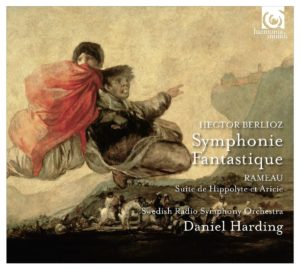One wouldn’t ordinarily link Rameau and Berlioz, yet these disparate composers prove compatible disc mates. Indeed, the energy, rhythmic élan, and occasional audacity conveyed in a suite of pieces from Rameau’s opera Hippolyte et Aricie complements the Symphonie fantastique’s curious fusion of chaste Classicism and foaming-at-the-mouth Romanticism.
Abetted by the proficient Swedish Radio Symphony Orchestra, Daniel Harding’s Rameau embraces certain precepts of the period-instrument movement like minimal vibrato and short phrase lengths without being rigid. Compare the lightness and forward momentum of his Ouverture or his First Rigaudon alongside the relatively stiff Kuijken/La Petite Bande versions, and hear for yourself. On the other hand, some of the less attractive HIP traits such as thin-to-emaciated string tone and pronounced feminine endings seep through Harding’s Symphonie fantastique.
His first-movement introduction Largo is swift and uneventful rather than brooding and mysterious, while the dolce woodwind repeated-note accompaniment slightly overbalances the violins’ theme. The Allegro agitato’s scaled-down dimensions, together with the conductor’s perfunctory response to the composer’s quirky tempo changes, minimize the dramatic outbursts that a comparably refined conductor like Herbert von Karajan manages to bring out to the proverbial max.
In Le bal, it’s good to hear the optional cornet part, along with unusual timbral distinction between the two harps, although the latter’s ascending triplets seem to lag a bit in the introduction, while Harding downplays those stinging cello and bass sforzandos. Despite colorful low brass snarls and well-defined timpani work, the fourth movement finds Harding schlepping rather than marching to the gallows–and why does the tempo slow down for no good reason at measure 33? A conspicuous edit, perhaps?
Harding’s best work occurs in the third and fifth movements. If he minimizes Scènes aux champs’ climaxes, the animated basic tempo and textural transparency impart an understated urgency to Berlioz’s chamber-like scoring that all too often comes off sounding static and immobile. In the Dream of a Witches’ Sabbath finale, most of Berlioz’s ear-catching orchestration gestures are gauged with point, character, and finesse (save for unduly recessed strings in the opening section). In this respect Harding is similar to Michael Tilson Thomas, but the latter’s faster overall pace and supple exuberance ultimately win out.
Notwithstanding Harding’s unquestionably captivating moments, listeners seeking a Fantastique where a HIP aesthetic and a modern orchestra genuinely come together in sound, style, and spirit, the Norrington/SWR recording on Hänssler Classics remains a reference.
































